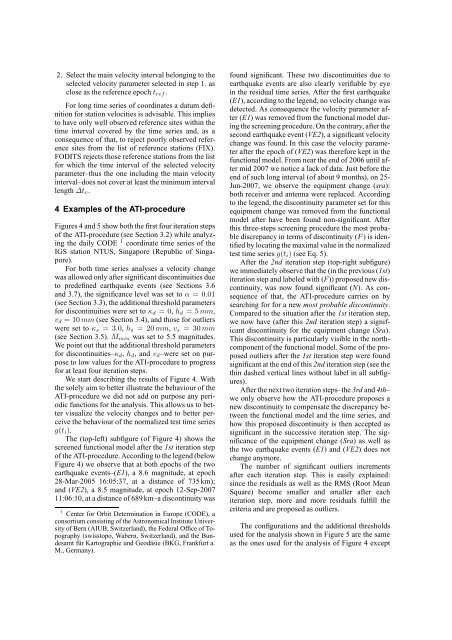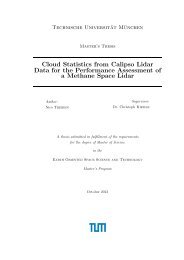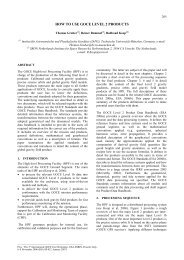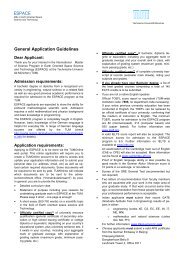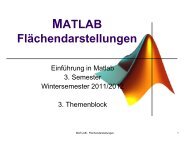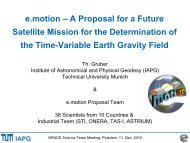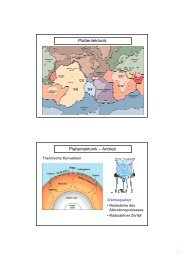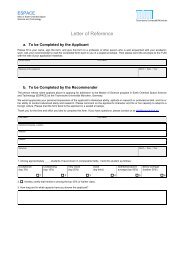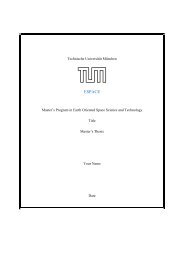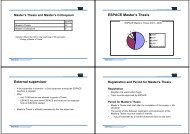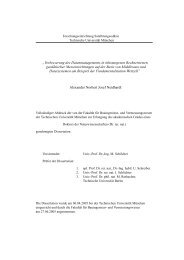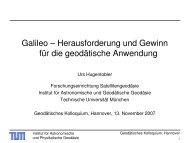FODITS - Institut für Astronomische und Physikalische Geodäsie ...
FODITS - Institut für Astronomische und Physikalische Geodäsie ...
FODITS - Institut für Astronomische und Physikalische Geodäsie ...
You also want an ePaper? Increase the reach of your titles
YUMPU automatically turns print PDFs into web optimized ePapers that Google loves.
2. Select the main velocity interval belonging to the<br />
selected velocity parameter selected in step 1. as<br />
close as the reference epoch tref .<br />
For long time series of coordinates a datum definition<br />
for station velocities is advisable. This implies<br />
to have only well observed reference sites within the<br />
time interval covered by the time series and, as a<br />
consequence of that, to reject poorly observed reference<br />
sites from the list of reference stations (FIX).<br />
<strong>FODITS</strong> rejects those reference stations from the list<br />
for which the time interval of the selected velocity<br />
parameter–thus the one including the main velocity<br />
interval–does not cover at least the minimum interval<br />
length ∆tv.<br />
4 Examples of the ATI-procedure<br />
Figures 4 and 5 show both the first four iteration steps<br />
of the ATI-procedure (see Section 3.2) while analyzing<br />
the daily CODE 1 coordinate time series of the<br />
IGS station NTUS, Singapore (Republic of Singapore).<br />
For both time series analyses a velocity change<br />
was allowed only after significant discontinuities due<br />
to predefined earthquake events (see Sections 3.6<br />
and 3.7), the significance level was set to α = 0.01<br />
(see Section 3.3), the additional threshold parameters<br />
for discontinuities were set to κd = 0, hd = 5 mm,<br />
vd = 10 mm (see Section 3.4), and those for outliers<br />
were set to κs = 3.0, hs = 20 mm, vs = 30 mm<br />
(see Section 3.5). Mmin was set to 5.5 magnitudes.<br />
We point out that the additional threshold parameters<br />
for discontinuities–κd, hd, and vd–were set on purpose<br />
to low values for the ATI-procedure to progress<br />
for at least four iteration steps.<br />
We start describing the results of Figure 4. With<br />
the solely aim to better illustrate the behaviour of the<br />
ATI-procedure we did not add on purpose any periodic<br />
functions for the analysis. This allows us to better<br />
visualize the velocity changes and to better perceive<br />
the behaviour of the normalized test time series<br />
g(ti).<br />
The (top-left) subfigure (of Figure 4) shows the<br />
screened functional model after the 1st iteration step<br />
of the ATI-procedure. According to the legend (below<br />
Figure 4) we observe that at both epochs of the two<br />
earthquake events–(E1), a 8.6 magnitude, at epoch<br />
28-Mar-2005 16:05:37, at a distance of 735 km);<br />
and (VE2), a 8.5 magnitude, at epoch 12-Sep-2007<br />
11:06:10, at a distance of 689 km–a discontinuity was<br />
1 Center for Orbit Determination in Europe (CODE), a<br />
consortium consisting of the Astronomical <strong>Institut</strong>e University<br />
of Bern (AIUB, Switzerland), the Federal Office of Topography<br />
(swisstopo, Wabern, Switzerland), and the B<strong>und</strong>esamt<br />
<strong>für</strong> Kartographie <strong>und</strong> <strong>Geodäsie</strong> (BKG, Frankfurt a.<br />
M., Germany).<br />
fo<strong>und</strong> significant. These two discontinuities due to<br />
earthquake events are also clearly verifiable by eye<br />
in the residual time series. After the first earthquake<br />
(E1), according to the legend, no velocity change was<br />
detected. As consequence the velocity parameter after<br />
(E1) was removed from the functional model during<br />
the screening procedure. On the contrary, after the<br />
second earthquake event (VE2), a significant velocity<br />
change was fo<strong>und</strong>. In this case the velocity parameter<br />
after the epoch of (VE2) was therefore kept in the<br />
functional model. From near the end of 2006 until after<br />
mid 2007 we notice a lack of data. Just before the<br />
end of such long interval (of about 9 months), on 25-<br />
Jun-2007, we observe the equipment change (sra):<br />
both receiver and antenna were replaced. According<br />
to the legend, the discontinuity parameter set for this<br />
equipment change was removed from the functional<br />
model after have been fo<strong>und</strong> non-significant. After<br />
this three-steps screening procedure the most probable<br />
discrepancy in terms of discontinuity (F ) is identified<br />
by locating the maximal value in the normalized<br />
test time series g(ti) (see Eq. 5).<br />
After the 2nd iteration step (top-right subfigure)<br />
we immediately observe that the (in the previous (1st)<br />
iteration step and labeled with (F)) proposed new discontinuity,<br />
was now fo<strong>und</strong> significant (N). As consequence<br />
of that, the ATI-procedure carries on by<br />
searching for for a new most probable discontinuity.<br />
Compared to the situation after the 1st iteration step,<br />
we now have (after this 2nd iteration step) a significant<br />
discontinuity for the equipment change (Sra).<br />
This discontinuity is particularly visible in the northcomponent<br />
of the functional model. Some of the proposed<br />
outliers after the 1st iteration step were fo<strong>und</strong><br />
significant at the end of this 2nd iteration step (see the<br />
thin dashed vertical lines without label in all subfigures).<br />
After the next two iteration steps–the 3rd and 4th–<br />
we only observe how the ATI-procedure proposes a<br />
new discontinuity to compensate the discrepancy between<br />
the functional model and the time series, and<br />
how this proposed discontinuity is then accepted as<br />
significant in the successive iteration step. The significance<br />
of the equipment change (Sra) as well as<br />
the two earthquake events (E1) and (VE2) does not<br />
change anymore.<br />
The number of significant outliers increments<br />
after each iteration step. This is easily explained:<br />
since the residuals as well as the RMS (Root Mean<br />
Square) become smaller and smaller after each<br />
iteration step, more and more residuals fulfill the<br />
criteria and are proposed as outliers.<br />
The configurations and the additional thresholds<br />
used for the analysis shown in Figure 5 are the same<br />
as the ones used for the analysis of Figure 4 except


